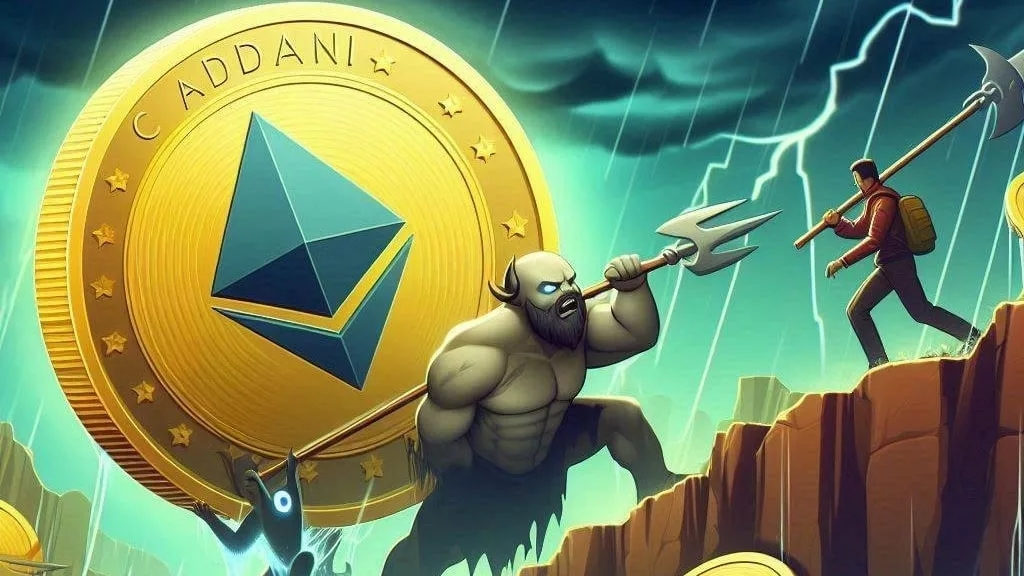
Cardano (ADA) holders have experienced a tumultuous week as the crypto currency’s price continues to slide, even as interest in decentralized finance (DeFi) within its ecosystem rises. Cardano’s decentralized exchange (DEX) daily volume has soared, surpassing 23 million ADA, highlighting a growing engagement in DeFi. However, this increased activity comes amidst a backdrop of declining total value locked (TVL) and other concerning indicators that suggest ADA holders might be in for a rough ride.
The surge in DEX volumes is an encouraging sign for Cardano, pointing to increased trading activity and liquidity within its network. However, this positive development is overshadowed by a significant drop in Cardano’s TVL. Data from Artemis shows that Cardano’s TVL has fallen sharply from $430 million to $230 million, a decline that raises questions about the overall health and attractiveness of its DeFi ecosystem.
Several factors contribute to this decline. One of the primary reasons is the apparent lack of sustained interest in Cardano’s decentralized applications (dApps). While the Cardano platform boasts a solid technological foundation, it seems to be struggling to attract and retain users for its dApps. Without compelling and widely adopted dApps, maintaining high TVL becomes a challenge.
Additionally, the NFT market on Cardano has faced setbacks. Last month saw a notable drop in both the floor price and overall transaction volume of popular NFTs on the network. This decline in NFT activity further erodes the value locked in the Cardano ecosystem, adding to the pressures on ADA holders.
The challenges within Cardano’s ecosystem are reflected in ADA’s price performance. At the time of writing, ADA is trading at $0.4489, following a trend characterized by lower lows and lower highs over recent weeks. This pattern indicates a persistent downtrend, which has left investors wary and uncertain about ADA’s future price movements.
Over the past few weeks, ADA’s price has fluctuated between $0.512 and $0.421. The $0.512 level has been tested multiple times, but each attempt to break through this resistance has been unsuccessful, underscoring the bearish sentiment prevailing in the market.
A detailed technical analysis of ADA reveals a landscape marked by weakness and declining momentum. One of the key indicators, the relative strength index (RSI), has shown a significant decline. The RSI measures the speed and change of price movements, and a declining RSI indicates weakening bullish momentum and increased selling pressure.
Similarly, the Chaikin Money Flow (CMF), which tracks the inflow and outflow of money into an asset, has also shown a sharp decline. This suggests a reduction in capital entering the ADA market, further exacerbating the downward pressure on its price.
Another concerning indicator is ADA’s velocity, which measures the frequency of transactions involving ADA. A declining velocity indicates that ADA is changing hands less frequently, reflecting reduced engagement and transaction activity within the network.
Furthermore, the Market Value to Realized Value (MVRV) ratio for ADA has dropped significantly. The MVRV ratio compares an asset’s market value to its realized value and provides insight into whether an asset is overvalued or undervalued. A declining MVRV ratio suggests that the profitability of ADA holdings has decreased, which can lead to increased selling as holders look to cut their losses.
The Long/Short ratio for ADA has also seen a decline, indicating a reduction in the number of long-term holders. This shift could suggest that confidence in ADA’s long-term prospects is waning among investors, leading to more short-term trading and increased volatility.
Despite the current challenges, there are potential catalysts that could drive a recovery for ADA. One of the most anticipated developments is the continued rollout of smart contract functionality through the Alonzo upgrade. This upgrade is expected to significantly enhance Cardano’s capabilities, enabling more complex and versatile dApps to be built on the platform. Successful implementation and adoption of smart contracts could attract new users and increase TVL, providing a much-needed boost to ADA’s price.
Strategic partnerships with leading DeFi protocols and projects could also play a crucial role in revitalizing Cardano’s ecosystem. By integrating with established DeFi platforms, Cardano can leverage their user bases and liquidity, driving greater engagement and adoption of its network.
Moreover, ongoing efforts to improve the overall user experience and developer tools on Cardano are essential. Making it easier for developers to build on Cardano and for users to interact with its dApps can help drive sustained growth and interest in the platform.
As Cardano navigates this complex and challenging landscape, its future will depend on the successful execution of its development roadmap and the ability to attract and retain users and developers. While the current indicators point to continued challenges for ADA holders, the underlying potential of Cardano’s technology and its growing DeFi ecosystem offer a glimmer of hope for recovery.
Investors and stakeholders will need to closely monitor key developments and market trends to navigate the ongoing volatility. As the DeFi sector continues to evolve, Cardano’s ability to adapt and innovate will be crucial in determining its place in the rapidly changing world of blockchain and cryptocurrencies.
Get the latest Crypto & Blockchain News in your inbox.